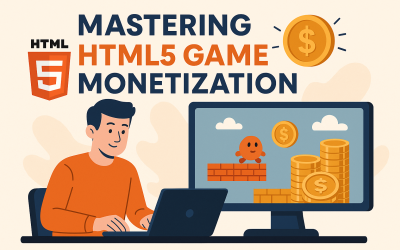The Good, the Bad, and the Ugly in Reward Video Ads for Games
Reward video ads have become one of the main income sources for game developers. Implementing these ads correctly can significantly boost revenue, while poor integration risks disrupting gameplay and alienating players. From the type of ad format to the exact placement within the game, developers need to make intentional choices when implementing reward video ads. Here’s a look at the different types of video ad monetization, some effective practices, and examples of both good and bad implementations in popular games.
Contents
Types of Video Ad Monetization
Video ads typically run between 15 and 30 seconds, and they come in various formats, each with its own advantages and challenges. Generally, video ads can be categorized into two types: forced and unforced ads, with further distinctions between voluntary and involuntary implementations. Understanding the differences between these types is crucial to creating a successful ad strategy.
1. Forced Video Ads
Forced video ads require the player to watch the ad entirely, with no option to skip. While these ads generate higher revenue due to guaranteed view completion, they can disrupt gameplay and negatively impact user experience if overused. Forced ads can be strategically placed during natural breaks in the game, such as between levels, but they come with the risk of lowering player retention if they feel too intrusive.
2. Unforced Video Ads
Unforced ads offer players the option to skip the ad after a few seconds. This setup improves the user experience by giving players more control, which can lead to higher engagement rates. However, revenue from unforced ads may be lower since only the ads watched in full contribute to earnings. Despite this, unforced ads can help maintain a positive player experience by offering an escape from repetitive ads.
3. Voluntary Ads
Voluntary ads, often referred to as opt-in ads, are player-triggered. Typically, these ads come with in-game rewards, such as extra lives, currency, or power-ups. Since players actively choose to watch these ads, they are seen less as interruptions and more as a gameplay feature. Voluntary ads usually yield high engagement and drive revenue without negatively impacting retention, as players feel in control.
4. Involuntary Ads
Involuntary ads appear without the player’s direct input, much like forced ads, but are usually displayed at specific points in the game, such as after completing a level or reaching a checkpoint. These ads can be effective if implemented thoughtfully but risk disrupting the player’s immersion. Developers need to be careful with involuntary ads, as overuse or poor placement can frustrate players.
Examples of Video Ad Implementation in Games
The best video ad strategies integrate ads in a way that feels natural to the player experience. Here are some effective approaches and examples of games that have successfully (and unsuccessfully) incorporated video ads.
1. Progression Ads
One of the most effective ways to incorporate video ads is by tying them to progression, offering players a way to advance by watching an ad. This strategy is commonly used in quiz and trivia games where players may need hints to continue.
Examples:
- Logo Quiz and Ultimate Trivia offer players hints if they watch a video ad, allowing them to progress without getting stuck. By framing ads as an optional part of gameplay, these games maintain engagement and prevent frustration.
- In this setup, video ads become an asset for players, who are more likely to watch willingly to gain the hints they need to move forward.
Why It Works:
This approach aligns ads with the player’s goals, making them feel like a helpful tool rather than an interruption. Since players engage with the ad to overcome obstacles, they view ads as beneficial rather than disruptive.
2. Checkpoint Ads
Another popular strategy is to allow players to restart from a checkpoint if they watch an ad. This option often appears after a player loses or reaches a significant milestone in the game. By offering a second chance in exchange for watching an ad, developers can monetize without diminishing the overall player experience.
Examples:
- BLUK and Shooty Skies both use this model, offering players the option to watch an ad to restart at a checkpoint. This way, players can continue from where they left off without feeling punished for their mistakes.
- Slashy Hero uses a similar approach, giving players the option to revive and keep playing if they watch a video ad.
Why It Works:
Checkpoint ads offer a form of relief for players, allowing them to recover from setbacks without having to restart entirely. This model respects the player’s progress, making ads feel like a helpful addition rather than an interruption.
3. Reward Ads
Reward ads allow players to gain in-game bonuses, such as currency or power-ups, in exchange for watching a video ad. This strategy is one of the most popular and effective ad models, as players feel they’re receiving tangible benefits that enhance their gameplay.
Examples:
- In Tap Titans, players can watch an ad to receive in-game currency or power-ups. This approach helps players feel more capable in the game, enhancing satisfaction.
- Bitcoin Billionaire takes it a step further by offering players the option to multiply their rewards by watching an ad, incentivizing engagement while making the rewards feel substantial.
Why It Works:
Reward ads add value to the player’s experience by providing something they want, such as power-ups or extra currency. Because players have control over whether to watch the ad, these ads feel more like a bonus than an interruption.
The Good, the Bad, and the Ugly of Reward Video Ads
While reward video ads can drive revenue and engagement, there are both good and bad practices in their implementation. Developers should aim to enhance gameplay with ads rather than detract from it. Here’s what to aim for—and what to avoid.
The Good
- Seamless Integration: Good reward video ads align with the game’s natural flow, such as progression or checkpoints. This keeps players engaged and willing to watch ads, as they feel they’re gaining something of value.
- Player Control: Allowing players to opt-in to watch ads (voluntary ads) provides a better user experience, as players feel they have control over when and how they engage with ads.
- Clear Communication: Informing players of the reward they’ll receive for watching an ad improves transparency and reduces frustration. Games like Candy Crush make it clear that players can choose to watch an ad for additional lives.
The Bad
- Excessive Forced Ads: Forcing players to watch ads too frequently can drive them away. Overusing forced ads, particularly during intense gameplay moments, can interrupt the experience and make the game feel like a marketing platform rather than entertainment.
- Lack of Clear Rewards: If players watch ads without gaining meaningful rewards, they may feel cheated. Ads should offer something valuable, and rewards should be directly linked to the gameplay to maintain engagement.
The Ugly
- Intrusive Involuntary Ads: Ads that appear without the player’s control, particularly during critical moments, can frustrate players and cause drop-offs. Games that bombard players with involuntary ads often suffer from high churn rates.
- Disrupting Game Flow: Ads that disrupt gameplay flow, such as placing a forced ad immediately after a difficult level, can negatively impact the experience. If ads become a source of irritation, players are likely to quit the game entirely.
Balancing Monetization and Player Experience
The key to successful reward video ads is balance. Developers need to integrate ads in a way that respects the player experience and complements gameplay. Excessive or poorly placed ads can lead to player frustration, reducing engagement and hurting long-term retention. However, thoughtful ad placements—where ads offer real value and enhance gameplay—can lead to better monetization and positive player feedback.
Best Practices for Reward Video Ads:
- Integrate Ads Seamlessly: Align ad placements with moments when players naturally pause, like checkpoints or end-of-level screens.
- Offer Meaningful Rewards: Make sure rewards for watching ads are worthwhile and relevant to the player’s progress.
- Test and Optimize: Regularly test ad placements and track player behavior to find the ideal balance between revenue and retention.
- Give Players Control: Whenever possible, let players opt into ads rather than forcing them. Voluntary ads lead to better engagement and satisfaction.
Final Thoughts: Reward Video Ads as a Strategic Tool
Reward video ads offer significant revenue potential, but they must be implemented carefully. By following best practices and focusing on player experience, developers can use ads to enhance engagement rather than disrupt it. The goal is to create a monetization strategy that feels like a natural part of the game, turning ads into assets rather than obstacles. With the right approach, reward video ads can be both profitable for developers and enjoyable for players.
About AppLixir:
AppLixir specializes in reward video ad monetization for web, mobile, and Facebook games. With AppLixir, developers can integrate player-friendly ads that drive revenue without disrupting gameplay. Visit AppLixir.com for more information.



